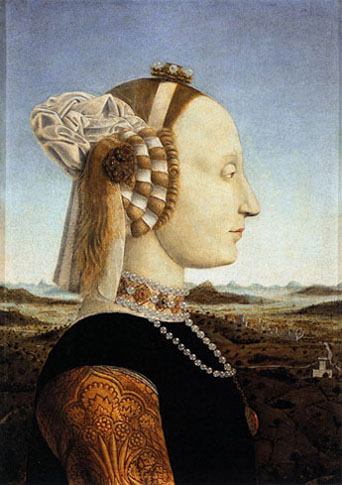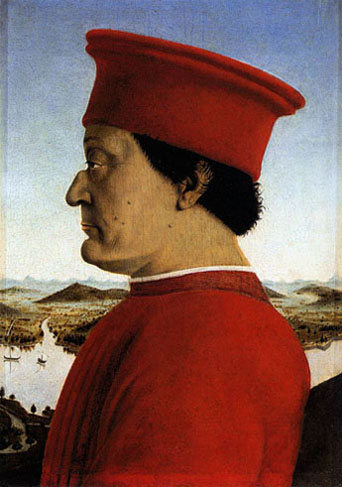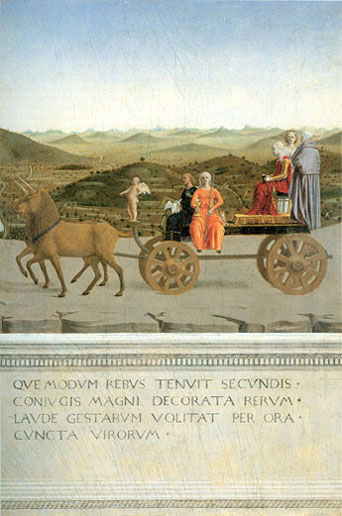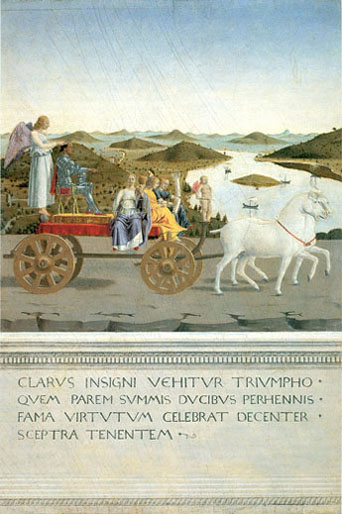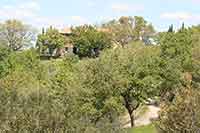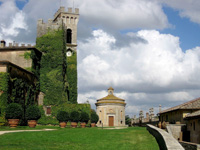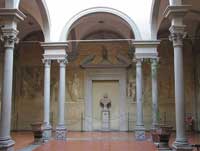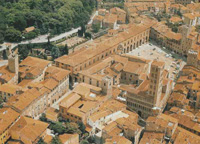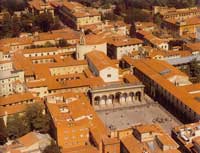Piero della Francesca, an Italian artist, one of the greatest artists of the Early Renaissance. His painting art is characterized by its serene humanism and its use of geometric forms, particularly in relation to perspective. He wrote books on solid geometry and on perspective, and his works reflect these interests. Francesca's solid, rounded figures are derived from Masaccio, while from Domenico he absorbed a predilection for delicate colors and scenes bathed in cool, clear daylight. To these influences he added an innate sense of order and clarity. He conceived of the human figure as a volume in space, and the outlines of his subjects have the grace, abstraction, and precision of geometric drawings. Almost all of Piero's works are religious in nature - primarily altarpieces and church frescoes in which he presents scenes of astonishing beauty, with silent, stately figures fixed in clear, crystalline space. There are always large areas of white or near-white in his works, the skies are big, light and sunny. The monumental quality of his figures, the perspectival construction of the pictorial space and the spiritual calm of his compositions led, throughout Italy, to the final surmounting of the Gothic style and prepared the way for the artistic achievements of High Renaissance in Italy.
The Montefeltro family in Urbino was Piero's most generous patron towards 1465. The diptich with the portraits of Battista Sforza and Federico da Montefeltro can be dated at the beginning of this period. In these two relatively small panels Piero attempts a very difficult compositional construction, that had never been attempted before. Behind the profile portrait of the two rulers, which is iconographically related to the heraldic tradition of medallion portraits, the artist adds an extraordinary landscape that extends so far that its boundaries are lost in the misty distance. Yet the relationship between the landscape and the portraits in the foreground is very close, also in meaning: for the portraits, with the imposing hieratic profiles, dominate the painting just as the power of the rulers portrayed dominates over the expanse of their territories. The daringness of the composition lies in this sudden switch between such distant perspective planes.
Piero's ability in rendering volumes is accompanied by his attention to detail. Through his use of light, he gives us a miniaturistic description of Sforza's jewels, of the wrinkles, moles and blemishes on Federico's olive-coloured skin. As in all portraits of the Duke, including this one by Piero della Francesca, we only see his left profile; a swordblow earlier in his life had cost him his right eye and the bridge of his nose.
Both lack of the right eye and the unusual shape of the nose were the results of an accident at a tournament. He actually had surgeons entirely remove the injured bridge of his nose to improve a field of vision of his survived eye, so he was less vulnerable to assassination attempts.
|
The panels depicting the Duke and Duchess of Urbino are both painted on the reverse in a style that can be regarded as miniature. The left picture shows the reverse side of the Portrait of Battista Sforza. It represents a Triumph matching that on the reverse of the portrait of her husband, and it is shown in the same scale. Battista Sforza was the daughter of Alessandro Sforza, the ruler of Pesaro, and the wife of Federigo da Montefeltro, the ruler of Urbino.
This right picture shows the reverse side of the Portrait of Federico da Montefeltro. It is the image of a triumphal carriage pulled by white horses. The Duke is shown in his role as a professional soldier, baton in hand, and dressed in shining armor. A humanistic Latin inscription praising Federico is shown below. |
![]()

